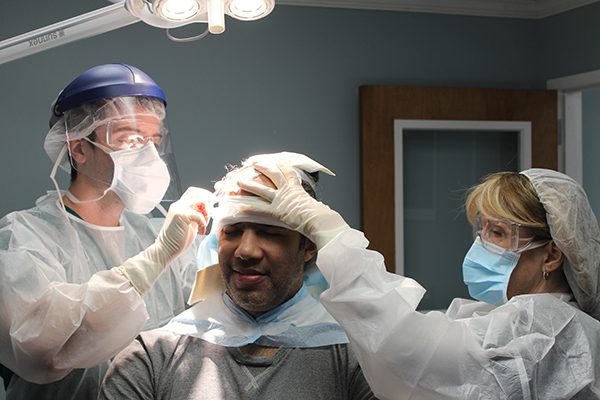FUT most commonly stands for “Follicular Unit Transplant” also known as the “strip” procedure – sometimes also called “FUSS” or “Follicular Unit Strip Surgery.” It is one of the two modern harvesting options available for hair transplant patients today. It differs from “FUE,” the other well-known harvesting method, in the way the follicles are harvested, the amount of hair that can be safely moved in one sitting, and the ability to have more surgery in the future. The debate regarding the results from FUT versus FUE still rages today as well.
During the FUT procedure, the doctor maps out the thickest, healthiest section of follicles in the safe donor area (the sides and back of the scalp), cleans and numbs the area, and then uses a blade to make a linear incision and meticulously remove a narrow “strip” of hair-bearing skin from this “sweet spot.” The area is then immediately closed with sutures or staples and hidden underneath the surrounding hair. The staples or stitches will be removed around 10 days later and the incision line will heal into a fine linear scar which is typically 1-2mm in width and difficult to appreciate – even with shorter hair.
The strip is then given to trained hair transplant technicians who place it under high-powered microscopes and use blades to surgically divide it down into the individual follicular units – the “grafts” we use for transplantation. The ability to remove and dissect down to the level of the follicles with such care and precision creates the highest quality grafts. These grafts suffer no trauma and contain the perfect amount of supportive tissue; just enough to ensure excellent survival and growth, but not too much to the point where the grafts appear ill-refined or “chunky” and lead to worse results.
Because FUT harvesting targets the best area of the donor zone and removes the tissue as one unified segment, it typically allows for the greatest number of grafts in one sitting. And because the edges of the strip area are brought together during closure, the density of the donor region – aside from the small linear scar – remains unchanged. Clinics with large facilities and highly-trained staff can perform these ultra-refined “FUT mega-sessions,” and routinely move thousands of grafts with excellent growth and minimal damage in the donor region. Since the only area of “damage” in the donor area is a small linear scar and all tissue around it is untouched, virgin, and available for future surgery, FUT also allows for the greatest number of repeat procedures and the greatest number of life-time grafts – particularly in patients who do FUT first and then FUE later on.
The gentle, atraumatic nature of FUT leads to incredible growth rates. Studies put the growth yields at somewhere between 95-98% growth (meaning for every 100 follicular units you move via the FUT technique, approximately 95-98 of them survive and thrive). FUT also tends to produce the thickest, most natural growth from each follicle. The same cannot be said consistently for FUE. While it is an excellent, modern technique, studies show growth is variable and not typically as consistent as FUT on a wide scale.














